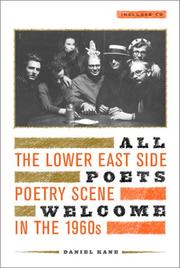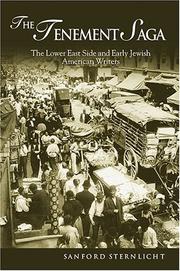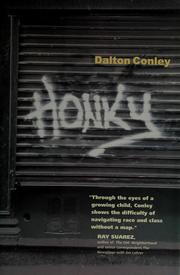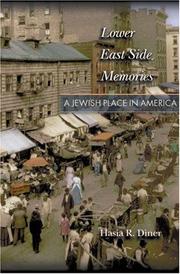| Listing 1 - 6 of 6 |
Sort by
|

ISBN: 0520233859 0520233840 9786612762666 1282762664 0520936434 9780520936430 9780520233850 9780520233843 9781282762664 6612762667 Year: 2003 Publisher: Berkeley : University of California Press,
Abstract | Keywords | Export | Availability | Bookmark
 Loading...
Loading...Choose an application
- Reference Manager
- EndNote
- RefWorks (Direct export to RefWorks)
This landmark book, together with its accompanying CD, captures the heady excitement of the vibrant, irreverent poetry scene of New York's Lower East Side in the 1960's. Drawing from personal interviews with many of the participants, from unpublished letters, and from rare sound recordings, Daniel Kane brings together for the first time the people, political events, and poetic roots that coalesced into a highly influential community. From the poetry-reading venues of the early sixties, such as those at the Les Deux Mégots and Le Metro coffeehouses to The Poetry Project at St. Mark's Church, a vital forum for poets to this day, Kane traces the history of this literary renaissance, showing how it was born from a culture of publicly performed poetry. The Lower East Side in the sixties proved foundational in American verse culture, a defining era for the artistic and political avant-garde. The voices and works of John Ashbery, Amiri Baraka, Charles Bernstein, Bill Berkson, Ted Berrigan, Kenneth Koch, Bernadette Mayer, Ron Padgett, Denise Levertov, Paul Blackburn, Frank O'Hara, and many others enliven these pages, and the thirty five-track CD includes recordings of several of the poets reading from their work in the sixties and seventies. The Lower East Side's cafes, coffeehouses, and salons brought together poets of various aesthetic sensibilities, including writers associated with the so-called New York School, Beats, Black Mountain, Deep Image, San Francisco Renaissance, Umbra, and others. Kane shows that the significance for literary history of this loosely defined community of poets and artists lies in part in its reclaiming an orally centered poetic tradition, adapted specifically to open up the possibilities for an aesthetically daring, playful poetics and a politics of joy and resistance.
American poetry --- Poets, American --- History and criticism. --- Homes and haunts --- Poetry --- American literature --- anno 1960-1969 --- New York City --- American poets --- Lower East Side (New York, N.Y.) --- LES (New York, N.Y.) --- East Side, Lower (New York, N.Y.) --- Intellectual life. --- In literature.

Abstract | Keywords | Export | Availability | Bookmark
 Loading...
Loading...Choose an application
- Reference Manager
- EndNote
- RefWorks (Direct export to RefWorks)
Jodinnen --- Juives --- Women [Jewish ] --- Jews --- -Hebrews --- Israelites --- Jewish people --- Jewry --- Judaic people --- Judaists --- Ethnology --- Religious adherents --- Semites --- Judaism --- Lower East Side (New York, N.Y.) --- New York (N.Y.) --- -New York (N.Y.) --- -United States --- United States --- Intellectual life --- Social conditions --- Emigration and immigration. --- Immigration --- -Lower East Side (New York, N.Y.) --- Hebrews --- Intellectual life. --- Social conditions. --- History --- Migrations --- Sources --- Education --- Religious life --- New York (State) --- LES (New York, N.Y.) --- East Side, Lower (New York, N.Y.) --- Lower East Side (New York, N.Y.).

ISBN: 1282269666 9786612269660 0299204839 9780299204839 0299204804 9780299204808 0299204847 9780299204846 9781282269668 6612269669 Year: 2004 Publisher: Madison, Wis. : University of Wisconsin Press/ Terrace Books,
Abstract | Keywords | Export | Availability | Bookmark
 Loading...
Loading...Choose an application
- Reference Manager
- EndNote
- RefWorks (Direct export to RefWorks)
American literature --- Authors, American --- Jewish authors --- Jews --- Judaism and literature --- Tenement houses --- Immigrants in literature. --- Jews in literature. --- Immigrants in literature --- Jews in literature --- American Literature --- English --- Languages & Literatures --- Tenements (Apartment houses) --- Apartment houses --- Literature and Judaism --- Literature --- Hebrews --- Israelites --- Jewish people --- Jewry --- Judaic people --- Judaists --- Ethnology --- Religious adherents --- Semites --- Judaism --- Authors --- English literature --- Agrarians (Group of writers) --- History and criticism. --- Homes and haunts --- Intellectual life. --- History and criticism --- Intellectual life --- Lower East Side (New York, N.Y.) --- LES (New York, N.Y.) --- In literature. --- History. --- East Side, Lower (New York, N.Y.)

ISBN: 0520921739 1597346608 9780520921733 0585391130 9780585391137 0520215869 9780520215863 9781597346603 9780520397842 0520397843 Year: 2000 Publisher: Berkeley : University of California Press,
Abstract | Keywords | Export | Availability | Bookmark
 Loading...
Loading...Choose an application
- Reference Manager
- EndNote
- RefWorks (Direct export to RefWorks)
This intensely personal and engaging memoir is the coming-of-age story of a white boy growing up in a neighborhood of predominantly African American and Latino housing projects on New York's Lower East Side. Vividly evoking the details of city life from a child's point of view-the streets, buses, and playgrounds-Honky poignantly illuminates the usual vulnerabilities of childhood complicated by unusual circumstances. As he narrates these sharply etched and often funny memories, Conley shows how race and class shaped his life and the lives of his schoolmates and neighbors. A brilliant case study for illuminating the larger issues of inequality in American society, Honky brings us to a deeper understanding of the privilege of whiteness, the social construction of race, the power of education, and the challenges of inner-city life. Conley's father, a struggling artist, and his mother, an aspiring writer, joined Manhattan's bohemian subculture in the late 1960's, living on food stamps and raising their family in a housing project. We come to know his mother: her quirky tastes, her robust style, and the bargains she strikes with Dalton-not to ride on the backs of buses, and to always carry money in his shoe as protection against muggers. We also get to know his father, his face buried in racing forms, and his sister, who in grade school has a burning desire for cornrows. From the hilarious story of three-year-old Dalton kidnapping a black infant so he could have a baby sister to the deeply disturbing shooting of a close childhood friend, this memoir touches us with movingly rendered portraits of people and the unfolding of their lives. Conley's story provides a sophisticated example of the crucial role culture plays in defining race and class. Both of Conley's parents retained the "cultural capital" of the white middle class, and they passed this on to their son in the form of tastes, educational expectations, and a general sense of privilege. It is these advantages that ultimately provide Conley with his ticket to higher education and beyond. A tremendously good read, Honky addresses issues both timely and timeless that pertain to us all.
Children, White --- Whites --- African American children --- Hispanic American children --- Race awareness in children --- Social classes --- Class distinction --- Classes, Social --- Rank --- Caste --- Estates (Social orders) --- Social status --- Class consciousness --- Classism --- Social stratification --- Child psychology --- Children, Hispanic American --- Children --- Afro-American children --- Children, African American --- Negro children --- White people --- White persons --- Ethnology --- Caucasian race --- White children --- Social conditions. --- Race identity --- History --- Lower East Side (New York, N.Y.) --- LES (New York, N.Y.) --- East Side, Lower (New York, N.Y.) --- Biography. --- Biographies --- Life histories --- Memoirs --- Auxiliary sciences of history --- Genealogy --- african american. --- artists. --- autobiography. --- biography. --- bohemian. --- city life. --- class. --- coming of age. --- cultural capital. --- cultural tastes. --- death. --- disability. --- education. --- entertainment. --- higher education. --- housing projects. --- inequality. --- inner city. --- latino community. --- leisure. --- lower east side. --- memoir. --- minorities. --- new york. --- nonfiction. --- poverty. --- prejudice. --- privilege. --- race. --- racial difference. --- racism. --- shooting. --- social construction of race. --- social issues. --- success. --- violence. --- whiteness.
Book
ISBN: 0823279286 082327926X Year: 2018 Publisher: New York, NY : Baltimore, Md. : Fordham University Press, Project MUSE,
Abstract | Keywords | Export | Availability | Bookmark
 Loading...
Loading...Choose an application
- Reference Manager
- EndNote
- RefWorks (Direct export to RefWorks)
In the midst of current debates about the accessibility of public spaces, resurfacing as a result of highly visible demonstrations and occupations, this book illuminates an overlooked domain of civic participation: the office, workshop, or building where activist groups meet to organize and plan acts of political dissent and collective participation. Author Nandini Bagchee examines three re-purposed buildings on the Lower East Side that have been used by activists to launch actions over the past forty years. The Peace Pentagon was the headquarters of the anti-war movement, El Bohio was a metaphoric “hut” that envisioned the Puerto Rican Community as a steward of the environment, and ABC No Rio, appropriated from a storefront sign with missing letters, was a catchy punk name that appealed to the anarchistic sensibility of the artists that ran a storefront gallery in a run-down tenement. In a captivating discussion of buildings and urban settings as important components of progressive struggles in New York City over more than a century, Bagchee reveals how these collectively organized spaces have provided a venue for political participation while existing as a vital part of the city’s civic infrastructure. The “counter institution” explored in this book represents both a conceptual and a literal struggle to create a space for civic action in a city that is built upon real estate speculation. The author reveals the fascinating tension between the impermanence of the insurgent activist practices and the permanent but maintenance heavy aspects of architecture. The actors she vividly describes—the war resisters, the Puerto Rican organizers, the housing activists, the punks and artists—all seized the opportunity to create what are seen as “activist estates,” at a time and in a place where urban life itself was under attack. And now, when many such self-organized “activist” buildings are imperiled by the finance-driven real estate market that is New York City, this book takes stock and provides visibility to these under recognized citizens’ initiatives. Counter Institution is an innovative work that intersects architecture, urban design practices, and geography (cartography) on the one hand, with history, politics, and sociology on the other. It is a must-read for anyone interested in the history of activism in New York City and how the city can inspire and encourage political engagement. Through its beautifully illustrated pages—where drawings, maps, timelines, and photographs underline the connections between people, politics, and space—readers will discover new ways to imagine buildings as a critical part of the civic infrastructure and a vital resource for the future.
Community centers --- Public spaces --- Public spaces-New York (State)-New York. --- ARCHITECTURE / History / Contemporary (1945-). --- History. --- ABC No Rio. --- Activism. --- Architecture. --- Artists. --- Collective Spaces. --- El Bohio. --- Lower East Side. --- New York City. --- Peace Pentagon. --- Politics. --- Public places --- Social areas --- Urban public spaces --- Urban spaces --- Cities and towns --- Community learning centers --- Learning centers, Community --- Learning centers, School-based --- Play centers --- School-based learning centers --- School buildings --- Schools as social centers --- Social centers --- Public buildings --- Social settlements --- Sports facilities --- Playgrounds --- Recreation --- School facilities --- Community use --- Extended use --- Lower East Side (New York, N.Y.) --- New York (State) --- Buildings, structures, etc. --- LES (New York, N.Y.) --- East Side, Lower (New York, N.Y.) --- Lower --- New York (City)

ISBN: 0691007470 Year: 2002 Publisher: Oxford, England : Princeton University Press,
Abstract | Keywords | Export | Availability | Bookmark
 Loading...
Loading...Choose an application
- Reference Manager
- EndNote
- RefWorks (Direct export to RefWorks)
Manhattan's Lower East Side stands for Jewish experience in America. With the possible exception of African-Americans and Harlem, no ethnic group has been so thoroughly understood and imagined through a particular chunk of space. Despite the fact that most American Jews have never set foot there--and many come from families that did not immigrate through New York much less reside on Hester or Delancey Street--the Lower East Side is firm in their collective memory. Whether they have been there or not, people reminisce about the Lower East Side as the place where life pulsated, bread tasted better, relationships were richer, tradition thrived, and passions flared. This was not always so. During the years now fondly recalled (1880-1930), the neighborhood was only occasionally called the Lower East Side. Though largely populated by Jews from Eastern Europe, it was not ethnically or even religiously homogenous. The tenements, grinding poverty, sweatshops, and packs of roaming children were considered the stuff of social work, not nostalgia and romance. To learn when and why this dark warren of pushcart-lined streets became an icon, Hasia Diner follows a wide trail of high and popular culture. She examines children's stories, novels, movies, museum exhibits, television shows, summer-camp reenactments, walking tours, consumer catalogues, and photos hung on deli walls far from Manhattan. Diner finds that it was after World War II when the Lower East Side was enshrined as the place through which Jews passed from European oppression to the promised land of America. The space became sacred at a time when Jews were simultaneously absorbing the enormity of the Holocaust and finding acceptance and opportunity in an increasingly liberal United States. Particularly after 1960, the Lower East Side gave often secularized and suburban Jews a biblical, yet distinctly American story about who they were and how they got here. Displaying the author's own fondness for the Lower East Side of story books, combined with a commitment to historical truth, Lower East Side Memories is an insightful account of one of our most famous neighborhoods and its power to shape identity.
Immigrants --- Jews --- Social life and customs --- Intellectual life --- HISTORY / Jewish. --- Hebrews --- Israelites --- Jewish people --- Jewry --- Judaic people --- Judaists --- Ethnology --- Religious adherents --- Semites --- Judaism --- Emigrants --- Foreign-born population --- Foreign population --- Foreigners --- Migrants --- Persons --- Aliens --- Lower East Side (New York, N.Y.) --- New York (State) --- LES (New York, N.Y.) --- Nyu Yorḳ (State) --- NYS --- Niyū Yūrk (State) --- Nʹi︠u︡-Ĭork (State) --- Shtat Nʹi︠u︡ Ĭork --- State of New York --- State of N. York --- NY (State) --- N.Y. (State) --- N. York (State) --- نيويورك (State) --- ولاية نيويورك --- Wilāyat Niyū Yūrk --- Штат Нью-Ёрк --- Нью-Ёрк (State) --- Ню Йорк (State) --- Nova York (State) --- С̧ӗнӗ Йорк (State) --- Śĕnĕ Ĭork (State) --- Efrog Newydd (State) --- Kin Yótʼááh Deezʼá Hahoodzo --- Nííyóó Hahoodzo --- New Yorgi osariik --- Νέα Υόρκη (State) --- Nea Yorkē (State) --- Πολιτεία της Νέας Υόρκης --- Politeia tēs Neas Yorkēs --- Nueva York (State) --- Estado de Nueva York --- Nov-Jorkio --- Ŝtato de Nov-Jorkio --- État de New York --- Nua-Eabhrac (State) --- York Noa (State) --- Eabhraig Nuadh (State) --- Estado de Nova York --- Néu-Yok (State) --- Шин Йорк (State) --- Shin Ĭork (State) --- 뉴욕 주 --- Nyuyok-ju --- 뉴욕 (State) --- Nyuyok (State) --- Nuioka (State) --- Nú Yọk (State) --- Tchiaq York (State) --- New York Isifunda --- New York-fylki --- ניו יורק (State) --- מדינת ניו יורק --- Medinat Nyu Yorḳ --- Stat Evrek Nowydh --- Evrek Nowydh (State) --- Nou Yòk (State) --- Novum Eboracum (State) --- N̦ujorka (State) --- Niujorko valstija --- Niujorkas (State) --- Niorche (State) --- Њујорк (State) --- Njujork (State) --- Yancuīc York (State) --- ニューヨーク州 --- Nyū Yōku-shū --- ニューヨーク (State) --- Nyū Yōku (State) --- New York (Colony) --- Ethnic relations. --- Adler, Jacob. --- Aleichem, Sholem. --- American Vaudeville Theater. --- Baker, Zachary. --- Bible/Biblical. --- Café Metropole. --- Cahan, Abraham. --- Crossing Delancey. --- Current Literature. --- Diamond, Neil. --- Dissent. --- Eastern Europe. --- Eldridge Street Project. --- Ellis Island. --- Esther-Khaye. --- Forward. --- Franklin, Benjamin. --- Glackens, William. --- Goldreich, Gloria. --- Gropper, William. --- Hapgood, Hutchins. --- Humoresque. --- Industrial Removal Office. --- Jerusalem. --- Kelley, Florence. --- Levine, Lawrence. --- Lincoln, Abraham. --- Margolin, Elias. --- Mayflower. --- Raphaelson, Samuel. --- Rischin, Moses. --- Sanders, Ronald. --- Tenement Museum. --- The Jazz Singer. --- Uncle Moses. --- World War II/Holocaust. --- Yezierska, Anzia. --- Yiddish theater. --- Zagajewski, Adam. --- Zueblin, Charles. --- anti-Semitism. --- booksellers. --- business. --- food. --- garment industry. --- history. --- journalism. --- philanthropy. --- pogroms. --- settlement houses. --- summer camps. --- East Side, Lower (New York, N.Y.) --- Imigranci --- Żydzi --- obyczaje i zwyczaje --- życie intelektualne --- Nowy Jork (Stany Zjednoczone) --- stosunki międzyetniczne.
| Listing 1 - 6 of 6 |
Sort by
|

 Search
Search Feedback
Feedback About
About Help
Help News
News